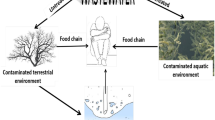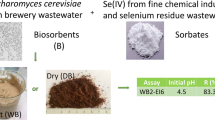Abstract
Heavy metal pollution is a matter of concern in industrialised countries. Contrary to organic pollutants, heavy metals are not metabolically degraded. This fact has two main consequences: its bioremediation requires another strategy and heavy metals can be indefinitely recycled. Yeast cells of Saccharomyces cerevisiae are produced at high amounts as a by-product of brewing industry constituting a cheap raw material. In the present work, the possibility of valorising this type of biomass in the bioremediation of real industrial effluents containing heavy metals is reviewed. Given the auto-aggregation capacity (flocculation) of brewing yeast cells, a fast and off-cost yeast separation is achieved after the treatment of metal-laden effluent, which reduces the costs associated with the process. This is a critical issue when we are looking for an effective, eco-friendly, and low-cost technology. The possibility of the bioremediation of industrial effluents linked with the selective recovery of metals, in a strategy of simultaneous minimisation of environmental hazard of industrial wastes with financial benefits from reselling or recycling the metals, is discussed.




Similar content being viewed by others
References
Amirnia S, Margaritis A, Ray MB (2012) Adsorption of mixtures of toxic metal ions using non-viable cells of Saccharomyces cerevisiae. Adsorpt Sci Technol 30:43–63
Avery SV, Tobin JM (1992) Mechanism of strontium uptake by laboratory and brewing strains of Saccharomyces cerevisiae. Appl Environ Microbiol 58:3883–3889
Blackwell KJ, Singleton I, Tobin JM (1995) Metal cation uptake by yeast: a review. Appl Microbiol Biotechnol 43:579–584
Boulton C, Quain D (2001) Brewing yeast and fermentation. Blackwell, Oxford
Brady D, Duncan JR (1994a) Bioaccumulation of metal-cations by Saccharomyces cerevisiae. Appl Microbiol Biotechnol 41:149–154
Brady D, Duncan JR (1994b) Cation loss during accumulation of heavy metal cations by Saccharomyces cerevisiae. Biotechnol Lett 16:543–548
Brady D, Stoll A, Duncan JR (1994a) Biosorption of heavy metal cations by non-viable yeast biomass. Environ Technol 15:429–438
Brady D, Stoll A, Duncan JR (1994b) Chemical and enzymatic extraction of heavy metal binding polymers from isolated cell walls of Saccharomyces cerevisiae. Biotechnol Bioeng 44:297–302
Butzke CE, Singelton VL (2008) Yeasts. In: Othmer DF, Kirk RE (eds) Kirk-Othmer food and feed technology, vol 2. Wiley, New York, pp 711–744
Chen C, Wang JL (2008) Investigating the interaction mechanism between zinc and Saccharomyces cerevisiae using combined SEM-EDX and XAFS. Appl Microbiol Biotechnol 79:293–299
Cojocaru C, Diaconu M, Cretescu I, Savic J, Vasic V (2009) Biosorption of copper(II) ions from aqua solutions using dried yeast biomass. Colloid Surf A-Physicochem Eng Asp 335:181–188
Colin VL, Villegas LB, Abate CM (2012) Indigenous microorganisms as potential bioremediators for environments contaminated with heavy metals. Int Biodeterior Biodegrad 69:28–37
Cui LZ, Wu GP, Jeong TS (2010) Adsorption performance of nickel and cadmium ions onto brewer's yeast. Can J Chem Eng 88:109–115
Dai SJ, Wei DZ, Zhou DQ, Jia CY, Wang YJ, Liu WG (2008) Removing cadmium from electroplating wastewater by waste Saccharomyces cerevisiae. Trans Nonferrous Metals Soc China 18:1008–1013
Dai QW, Dong FQ, Zhang W (2009) The biosorption effect and mechanism of Pb(II) on waste beer yeast. In: ICEET: Proceedings of the 2009 International Conference on Energy and Environment Technology, vol 2, Leee Computer Soc, Los Alamitos, pp 827–830
Dewulf J, Van der Vorst G, Denturck K, Van Langenhove H, Ghyoot W, Tytgat J, Vandeputte K (2010) Recycling rechargeable lithium ion batteries: critical analysis of natural resource savings. Resour Conserv Recycl 54:229–234
Ferraz AI, Teixeira JA (1999) The use of flocculating brewer´s yeast for Cr(III) and Pb(II) removal from residual wastewaters. Bioprocess Eng 21:431–437
Ferraz AI, Tavares T, Teixeira JA (2004) Cr(III) removal and recovery from Saccharomyces cerevisiae. Chem Eng J 105:11–20
Ferreira I, Pinho O, Vieira E, Tavarela JG (2010) Brewer's Saccharomyces yeast biomass: characteristics and potential applications. Trends Food Sci Technol 21:77–84
Florence TM (1983) Trace-element speciation and aquatic toxicology. Trac-Trends Anal Chem 2:162–166
Gadd GM (2009) Biosorption: critical review of scientific rationale, environmental importance and significance for pollution treatment. J Chem Technol Biotechnol 84:13–28
Gadd GM (2010) Metals, minerals and microbes: geomicrobiology and bioremediation. Microbiology 156:609–643
Gadd GM, Sayer JA (2000) Influence of fungi on the environmental mobility of metals and metalloids. In: Lovley DR (ed) Environmental micro-metal interactions. ASM Press, Washington D.C., pp 237–256
Ghorbani F, Younesi H, Ghasempouri SM, Zinatizadeh AA, Amini M, Daneshi A (2008) Application of response surface methodology for optimization of cadmium biosorption in an aqueous solution by Saccharomyces cerevisiae. Chem Eng J 145:267–275
Gibson BR, Lawrence SJ, Leclaire JPR, Powell CD, Smart KA (2007) Yeast responses to stresses associated with industrial brewery handling. FEMS Microbiol Rev 31:535–569
Han RP, Li HK, Li YH, Zhang JH, Xiao HJ, Shi J (2006) Biosorption of copper and lead ions by waste beer yeast. J Hazard Mat 137:1569–1576
Hughes MN, Poole RK (1991) Metal speciation and microbial-growth—the hard (and soft) facts. J Gen Microbiol 137:725–734
Huige NJ (2006) Brewery by-products and effluents. In: Priest FG, Stewart GG (eds) Handbook of brewing. CRC Press, Boca Raton, pp 655–713
Jenkins CL, Kennedy AI, Hodgson JA, Thurston P, Smart KA (2003) Impact of serial repitching on lager brewing yeast quality. J Am Brew Chem 61:1–9
Kordialik-Bogacka E (2011) Cadmium and lead recovery from yeast biomass. Cent Eur J Chem 9:320–325
Machado MD (2010) Removal and selective recovery of heavy metals from electroplating effluents. Ph.D. thesis, Porto University, Porto
Machado MD, Santos MSF, Gouveia C, Soares HMVM, Soares EV (2008) Removal of heavy metals using a brewer's yeast strain of Saccharomyces cerevisiae: the flocculation as a separation process. Bioresour Technol 99:2107–2115
Machado MD, Janssens S, Soares HMVM, Soares EV (2009) Removal of heavy metals using a brewer's yeast strain of Saccharomyces cerevisiae: advantages of using dead biomass. J Appl Microbiol 106:1792–1804
Machado MD, Soares EV, Soares HMVM (2010a) Removal of heavy metals using a brewer's yeast strain of Saccharomyces cerevisiae: chemical speciation as a tool in the prediction and improving of treatment efficiency of real electroplating effluents. J Hazard Mat 180:347–353
Machado MD, Soares EV, Soares HMVM (2010b) Removal of heavymetals using a brewer’s yeast strain of Saccharomyces cerevisiae: application to the treatment of real electroplating effluents containing multielements. J Chem Technol Biotechnol 85:1353–1360
Machado MD, Soares EV, Soares HMVM (2010c) Selective recovery of copper, nickel and zinc from ashes produced from Saccharomyces cerevisiae contaminated biomass used in the treatment of real electroplating effluents. J Hazard Mat 184:357–363
Machado MD, Soares HMVM, Soares EV (2010d) Removal of chromium, copper and nickel from an electroplating effluent using a flocculent brewer’s yeast strain of Saccharomyces cerevisiae. Water Air Soil Poll 212:199–204
Machado MD, Soares EV, Soares HMVM (2011a) Impact of fluorides on the removal of heavy metals from an electroplating effluent using a flocculent brewer’s yeast strain of Saccharomyces cerevisiae. Chem Speciation Bioavail 23:237–242
Machado MD, Soares EV, Soares HMVM (2011b) Selective recovery of chromium, copper, nickel, and zinc from an acid solution using an environmentally friendly process. Environ Sci Pollut Res 18:1279–1285
Mack CL, Wilhelmi B, Duncan JR, Burgess JE (2011) Biosorptive recovery of platinum from platinum group metal refining wastewaters by immobilised Saccharomyces cerevisiae. Water Sci Technol 63:149–155
Mapolelo M, Torto N (2004) Trace enrichment of metal ions in aquatic environments by Saccharomyces cerevisiae. Talanta 64:39–47
Mapolelo M, Torto N, Prior B (2005) Evaluation of yeast strains as possible agents for trace enrichment of metal ions in aquatic environments. Talanta 65:930–937
Marques PA, Pinheiro HM, Teixeira JA, Rosa MF (1999) Removal efficiency of Cu2+, Cd2+ and Pb2+ by waste brewery biomass: pH and cation association effects. Desalination 124:137–144
Naja GM, Volesky B (2010a) Toxicity and sources of Pb, Cd, Hg, Cr, As and radionuclides in the environment. In: Wang LK, Chen JP, Hung YT, Shammas NK (eds) Handbook on heavy metals in the environment. CRC Press, Boca Raton, pp 13–61
Naja GM, Volesky B (2010b) Treatment of metal-bearing effluents: removal and recovery. In: Wang LK, Chen JP, Hung YT, Shammas NK (eds) Handbook on heavy metals in the environment. CRC Press, Boca Raton, pp 247–291
Naja GM, Murphy V, Volesky B (2010) Biosorption, metals. In: Flickinger M (ed) Encyclopedia of Industrial Biotechnology: bioprocess, bioseparation, and cell technology. Wiley, New York, pp 1–29
Özer A, Özer D (2003) Comparative study of the biosorption of Pb(II), Ni(II), and Cr(VI) ions onto S. cerevisiae: determination of biosorption heats. J Hazard Mat B 100:219–229
Padmavathy V (2008) Biosorption of nickel(II) ions by baker's yeast: kinetic, thermodynamic and desorption studies. Bioresour Technol 99:3100–3109
Padmavathy V, Vasudevan P, Dhingra SC (2003) Biosorption of nickel(II) ions on Baker's yeast. Process Biochem 38:1389–1395
Panteloglou AG, Smart KA, Cook DJ (2012) Malt-induced premature yeast flocculation: current perspectives. J Ind Microbiol Biotechnol 39:813–822
Parvathi K, Nagendran R (2007) Biosorption of chromium from effluent generated in chrome-electroplating unit using Saccharomyces cerevisiae. Sep Sci Technol 42:625–638
Parvathi K, Nagendran R, Nareshkumar R (2007) Lead biosorption onto waste beer yeast by-product, a means to decontaminate effluent generated from battery manufacturing industry. Electron J Biotechnol 10:92–105
Powell CD, Quain DE, Smart KA (2003) The impact of brewing yeast cell age on fermentation performance, attenuation and flocculation. FEMS Yeast Res 3:149–157
Ruta L, Paraschivescu C, Matache M, Avramescu S, Farcasanu IC (2010) Removing heavy metals from synthetic effluents using "kamikaze" Saccharomyces cerevisiae cells. Appl Microbiol Biotechnol 85:763–771
Shah D, Shen MWY, Chen W, Da Silva NA (2010) Enhanced arsenic accumulation in Saccharomyces cerevisiae overexpressing transporters Fps1p or Hxt7p. J Biotechnol 150:101–107
Soares EV (2011) Flocculation in Saccharomyces cerevisiae: a review. J Appl Microbiol 110:1–18
Soares EV, Soares H (2012) Bioremediation of industrial effluents containing heavy metals using brewing cells of Saccharomyces cerevisiae as a green technology: a review. Environ Sci Pollut R 19:1066–1083
Soares EV, De Coninck G, Duarte F, Soares H (2002) Use of Saccharomyces cerevisiae for Cu2+ removal from solution: the advantages of using a flocculent strain. Biotechnol Lett 24:663–666
Stewart GG (2009) The Horace Brown medal lecture: forty years of brewing research. J Inst Brew 115:3–29
Stoll A, Duncan JR (1996) Enhanced heavy metal removal from waste water by viable, glucose pretreated Saccharomyces cerevisiae cells. Biotechnol Lett 18:1209–1212
Stoll A, Duncan JR (1997) Implementation of a continuous-flow stirred bioreactor system in the bioremediation of heavy metals from industrial waste water. Environ Pollut 97:247–251
Strandberg GW, Shumate SE II, Parrot JR Jr (1981) Microbial cells as biosorbents for heavy metals: accumulation of uranium by Saccharomyces cerevisiae and Pseudomonas aeruginosa. Appl Environ Microbiol 41:237–245
van Wyk CS (2011) Removal of heavy metals from metal-containing effluent by yeast biomass. Afr J Biotechnol 10:11557–11561
Vaughan-Martini A, Martini A (1998) Saccharomyces Meyen ex Reess. In: Kurtzman CP, Fell JW (eds) The yeasts: a taxonomic study. Elsevier, Amsterdam, pp 358–371
Veelders M, Bruckner S, Ott D, Unverzagt C, Mosch HU, Essen LO (2010) Structural basis of flocculin-mediated social behavior in yeast. Proc Natl Acad Sci USA 107:22511–22516
Vidgren V, Londesborough J (2011) 125th Anniversary Review: yeast flocculation and sedimentation in brewing. J Inst Brew 117:475–487
Volesky B (2001) Detoxification of metal-bearing effluents: biosorption for the next century. Hydrometallurgy 59:203–216
Volesky B (2003) Sorption and biosorption. BV Sorbex, Inc, Montreal
Wang JL (2002) Biosorption of copper(II) by chemically modified biomass of Saccharomyces cerevisiae. Process Biochem 37:847–850
Wang J, Chen C (2006) Biosorption of heavy metals by Saccharomyces cerevisiae: a review. Biotechnol Adv 24:427–451
Wang JL, Chen C (2009) Biosorbents for heavy metals removal and their future. Biotechnol Adv 27:195–226
Wilhelmi BS, Duncan JR (1995) Metal recovery from Saccharomyces cerevisiae biosorption columns. Biotechnol Lett 17:1007–1012
Wilhelmi BS, Duncan JR (1996) Reusability of immobilised Saccharomyces cerevisiae with successive copper adsorption–desorption cycles. Biotechnol Lett 18:531–536
Yu JX, Tong M, Sun XM, Li BH (2008) Enhanced and selective adsorption of Pb2+ and Cu2+ by EDTAD-modified biomass of baker's yeast. Bioresour Technol 99:2588–2593
Zhao M, Duncan JR (1998) Column sorption of Cr(VI) from electroplating effluent using formaldehyde cross-linked Saccharomyces cerevisiae. Biotechnol Lett 20:603–606
Author information
Authors and Affiliations
Corresponding author
Rights and permissions
About this article
Cite this article
Soares, E.V., Soares, H.M.V.M. Cleanup of industrial effluents containing heavy metals: a new opportunity of valorising the biomass produced by brewing industry. Appl Microbiol Biotechnol 97, 6667–6675 (2013). https://doi.org/10.1007/s00253-013-5063-y
Received:
Revised:
Accepted:
Published:
Issue Date:
DOI: https://doi.org/10.1007/s00253-013-5063-y




